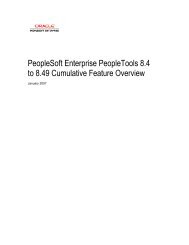COGNOS Business Intelligence Series 7
pes.pdf
pes.pdf
Create successful ePaper yourself
Turn your PDF publications into a flip-book with our unique Google optimized e-Paper software.
Chapter 3: Control Processes<br />
This chapter provides details about distributed server processes and what you can do to monitor<br />
and control the processes for optimum performance.<br />
Distributed Processing<br />
Cube data, containing a multidimensional representation of information, is processed by the<br />
query processor component of PowerPlay Enterprise Server. Report specifications, containing the<br />
report layout, are processed by the report processor component. Several processor instances may<br />
be started for a cube or report, and you can set the maximum number of processes for each cube<br />
or report. Each instance of a processor is called a process.<br />
PowerPlay Enterprise Server automatically balances the processing load by managing a set of<br />
processors for each cube and distributing requests for the cube data and report specifications<br />
among available processes. When a request arrives, the dispatcher forwards it to the first available<br />
processor associated with the requested cube or report.<br />
• For a Windows request, a connection with a single query processor is established for the<br />
duration of the session.<br />
• For a Web request, any of the available processors is chosen. In PowerPlay Web Explorer, a<br />
query processor is chosen each time the user performs an action, and the duration of the<br />
connection lasts only until the resulting HTML is generated. In PowerPlay Web Viewer, a<br />
report processor is chosen each time a report is run, and the duration of the connection lasts<br />
only until the resulting PDF is generated.<br />
If all the processors associated with the cube data or report specification are busy, PowerPlay<br />
Enterprise Server starts a new process, provided the maximum number of processes (p. 33) has<br />
not been reached. Only if this maximum is reached are requests put into a queue.<br />
In a distributed installation, security and reliability are important issues. To maximize<br />
performance in this type of environment, there are several settings you can adjust in PowerPlay<br />
Enterprise Server - Administration.<br />
If a problem results in a failed request by a process, the PowerPlay dispatcher kills that specific<br />
process and initiates a new one. Third-party diagnostic applications can cause problems for the<br />
dispatcher, interfering with the error recovery process. We recommend that diagnostic<br />
applications not be used on servers.<br />
Set the PowerPlay Service for User Logon<br />
By default, the Cognos PowerPlay Enterprise Server service is installed as a system account logon.<br />
For multiple PowerPlay machines to share data locations on a network, you must first assign a<br />
user logon account to the service.<br />
Ask your system administrator to create a special user account for the PowerPlay service that has<br />
the password defined to never expire.<br />
Steps<br />
1. In the Windows Control Panel, click Services.<br />
2. Click the Cognos PowerPlay Enterprise Server service and click Startup.<br />
3. In the Log On As panel, click This Account.<br />
4. In the list, click the special user account defined by your system administrator.<br />
5. In the Password text box, type the password for this account.<br />
6. In the Confirm Password text box, type the password again.<br />
Enterprise Server Guide 27
















